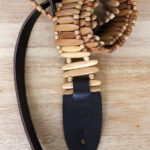Shopping for a guitar often leads players to consider the used market, and for good reason. A Used Acoustic Guitar can offer significant value, allowing you to acquire a higher-quality instrument for your budget. Beyond the financial advantages, a pre-owned guitar, especially a vintage model, carries a unique character and sound that new instruments often can’t replicate. However, navigating the world of used guitars requires some know-how to ensure you make a confident and informed purchase.
This guide will provide you with a detailed perspective on finding the perfect used acoustic guitar. We’ll cover everything from identifying your ideal instrument to inspecting its condition and understanding potential repair needs.
Part 1: Defining Your Needs and Where to Shop
Before diving into the used guitar market, it’s crucial to determine what you’re truly looking for. Are you a beginner seeking an affordable and playable instrument to start your musical journey? Or are you an experienced player with a specific vintage guitar in mind, perhaps a coveted 1940s Gibson J-45 with its iconic banner headstock?
Start by exploring different guitar types and models. Play as many instruments as possible, both new and used, to understand what feels comfortable in your hands and sounds pleasing to your ear. This hands-on experience is invaluable in shaping your preferences and expectations, as well as understanding price ranges. Don’t rush this exploration phase. Take your time to browse, play, and learn. This process of discovery might even lead you to adjust your initial idea of your dream used acoustic guitar.
Once you have a clearer picture of your desired guitar, the next step is to explore where to find used acoustic guitars for sale. Several avenues are available, each with its own advantages and considerations:
-
Vintage Guitar Dealers: Specialized vintage guitar dealers offer a curated selection of pre-owned instruments. The key advantage here is the opportunity to physically inspect and play the guitar before purchasing. Dealers often have expertise in assessing and sometimes repairing vintage instruments, potentially offering a degree of assurance about the guitar’s condition. While prices at vintage dealers might include a markup reflecting their expertise and services, you’re paying for convenience and a level of trust.
-
Private Sales: Buying directly from individual sellers can sometimes yield the best deals. However, it also requires more diligence on your part. You’ll need to be thorough in your inspection and assessment of the guitar’s condition. Consider why the owner is selling. Is it simply an upgrade, or are there underlying issues they’re trying to avoid addressing?
-
Online Marketplaces: Platforms like eBay and Reverb offer a vast online marketplace for used acoustic guitars. The internet expands your search geographically and provides a wide range of options. However, buying online requires extra caution. Prioritize sellers with excellent communication, detailed descriptions, and clear return policies in case the guitar isn’t as described or doesn’t meet your expectations upon arrival.
Regardless of where you choose to shop, remember that the internet has largely leveled the playing field in terms of pricing. Finding an unbelievably low “steal” is less likely today. Sellers can easily research fair market values, so expect to pay a reasonable price that aligns with the current market for the specific used acoustic guitar you’re interested in.
Part 2: Inspecting a Used Acoustic Guitar for Potential Issues
A crucial aspect of buying a used acoustic guitar is knowing how to inspect it thoroughly. Remember to factor in potential repair costs into your budget, as older guitars often require some level of maintenance or restoration. Even a basic setup, which includes truss rod adjustments and saddle or nut adjustments, can cost around $65 or more. More extensive repairs like crack repairs, neck resets, or refrets can significantly increase the overall investment.
When examining a used acoustic guitar, start with a comprehensive visual inspection:
Visual Once-Over:
-
Finish: Examine the finish on the top, back, and sides. The finish can reveal clues about the guitar’s history and care. Look for consistent finish appearance and note any dings, scratches, or areas that appear flaky or inconsistent, which might indicate moisture damage or impact.
-
Body Cracks and Seam Separations: Carefully check for any cracks in the wood or separations along the body seams. Minor, neatly repaired cracks or seams are often less concerning, especially if the exposed wood isn’t darkened, and the separated pieces haven’t warped significantly, indicating a long-standing issue. However, open seams or cracks requiring repair will add to your expenses.
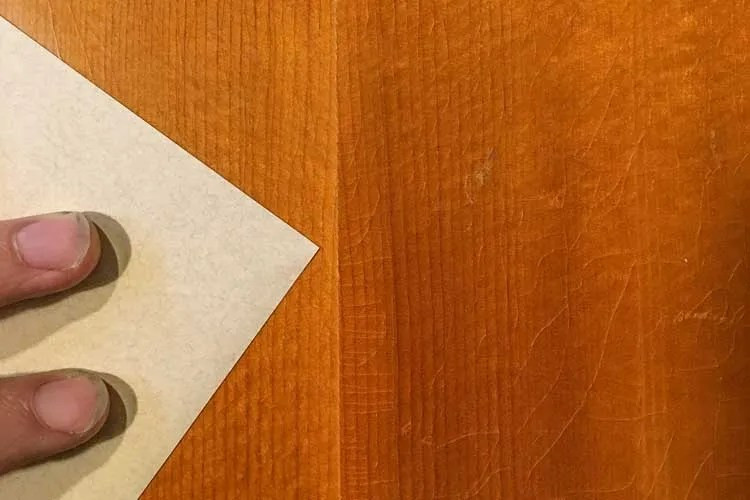 A close-up shot showing a neatly repaired lower-bout seam separation on an acoustic guitar, highlighting the clean repair work.
A close-up shot showing a neatly repaired lower-bout seam separation on an acoustic guitar, highlighting the clean repair work.
-
Bridge: Inspect the bridge to ensure it’s firmly glued to the guitar top. Try to slide a thin piece of paper under the edges and corners of the bridge. If the paper slips under any part, the bridge needs to be professionally re-glued. This is a critical repair, as a loose bridge negatively impacts sound quality and can stress the guitar top.
-
Neck Joint: Examine the neck joint where the neck meets the body. Look for any signs of separation, finish chipping, or discoloration along the heel. Chipping finish might suggest a previous neck reset, which, if well-executed, isn’t necessarily a negative, as it means this potentially costly repair has already been addressed.
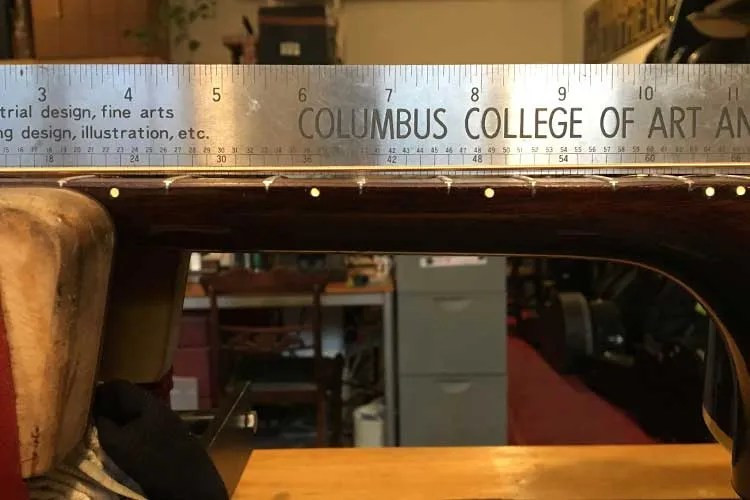 Image showing the heel of an acoustic guitar neck pulling away from the body, indicating a potentially serious issue.
Image showing the heel of an acoustic guitar neck pulling away from the body, indicating a potentially serious issue.
Neck Check:
The guitar neck is fundamental to playability and overall guitar health.
-
Neck Straightness: A slight neck relief (a slight bow) is normal and even desirable for acoustic guitars. However, excessive relief, twists, or unevenness (rollercoaster neck) can be significant problems.
-
Visual Sighting: Hold the guitar in playing position and sight down the neck from the headstock towards the body, focusing on the fretboard edge. This helps reveal obvious bends, dips, or twists.
-
Straightedge Test: For a more precise assessment, use an 18-inch straightedge. Place it along the tops of the frets while the guitar is tuned to pitch. This will show the amount of neck relief. Ideally, you should be able to slide a 0.010-inch feeler gauge under the string at the 8th fret, indicating proper relief.
 Image showing the heel of an acoustic guitar neck pulling away from the body, indicating a potentially serious issue.
Image showing the heel of an acoustic guitar neck pulling away from the body, indicating a potentially serious issue.
Playability Test:
After the visual and neck checks, it’s time to play the guitar. Bring your preferred pick, a capo, and if possible, a friend to listen from a distance.
- Play Every Note: Play up and down the neck on each string, checking for buzzing, dead spots, or notes that don’t ring clearly.
- Assess Action: Evaluate the string height (action). Is it comfortable for your playing style, or is it excessively high or low?
- Fret Condition: Pay attention to the frets. Minor unevenness might be corrected with a fret dress (leveling and re-crowning), but heavily worn or flattened frets will require a more expensive refret.
Part 3: Looking Inside for Deeper Insights
For a more in-depth evaluation, take a look inside the guitar’s body. A small mirror and a flashlight are essential tools for this internal inspection.
Bridge Plate Inspection:
The bridge plate, a piece of wood (often maple) beneath the bridge inside the guitar, reinforces the top and is crucial for sound and structural integrity.
-
Wear and Tear: Examine the bridge plate through the soundhole using your mirror and flashlight. Look at the holes where the bridge pins and string ball ends sit. Ideally, these holes should be clean and circular. Ragged or worn holes, or gouging between the holes, indicate wear and tear.
-
Cracks: In severe cases of neglect or prolonged issues with a loose bridge, the bridge plate itself can crack.
-
Repair/Replacement: Significant bridge plate wear or damage might necessitate repair or even replacement, which adds to the potential repair costs.
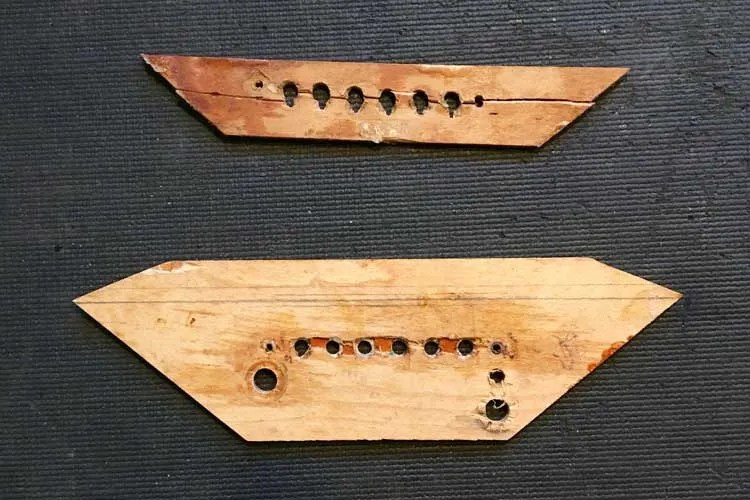 Close-up image of a worn bridge plate inside an acoustic guitar, showing elongated and damaged string holes.
Close-up image of a worn bridge plate inside an acoustic guitar, showing elongated and damaged string holes.
Internal Bracing and Crack Repairs:
While inside the guitar, scan the bracing (internal wooden supports) and look for any signs of cracks and repairs.
- Cleats: If you see cracks, check if small wooden patches (cleats) have been used to reinforce the repair. Well-executed crack repairs with cleats are generally acceptable and shouldn’t significantly impact the guitar’s sound. Neatness of these repairs can indicate the quality of previous maintenance.
Neck Angle Assessment:
Neck angle is critical for playability and sound. Over time, string tension can cause the neck angle to shift, raising the action.
-
Saddle and Bridge Height: Extremely low saddle height or a bridge that appears to have been shaved down are red flags. These are often attempts to compensate for a poor neck angle without performing a proper (and more costly) neck reset. Such shortcuts compromise sound quality and string vibration transfer to the top.
-
Straightedge Test for Neck Angle: Use an 18-inch straightedge. Place it on the fretboard, extending towards the bridge. If the straightedge rests just on top of the bridge or very close to it, the neck angle is likely in good shape. If the straightedge points significantly below the top of the bridge, the neck angle is too shallow, and a neck reset may be necessary.
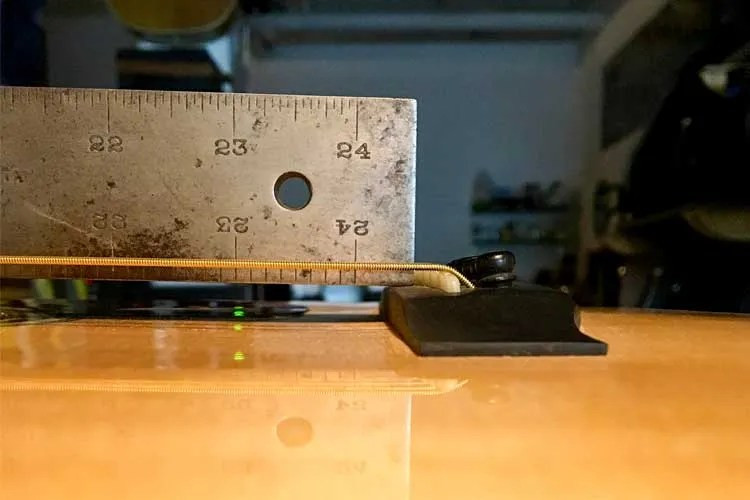 Image comparing a good neck angle and a bad neck angle on acoustic guitars using straightedges for visual demonstration.
Image comparing a good neck angle and a bad neck angle on acoustic guitars using straightedges for visual demonstration.
Neck Reset Consideration:
A neck reset is a major repair involving removing and resetting the neck to the correct angle. Many older guitars, particularly vintage Martins, will eventually require a neck reset. It’s a significant expense, and some shops may include a refret as part of the neck reset service.
Conclusion: Finding Your Perfect Used Acoustic Guitar
Despite potential repair considerations, buying a used acoustic guitar remains a smart choice. You often get more value for your money, and you gain access to instruments with a unique history and character. By following these inspection guidelines, you can approach the used guitar market with confidence, increasing your chances of finding the perfect, well-loved instrument that will inspire your playing for years to come.

